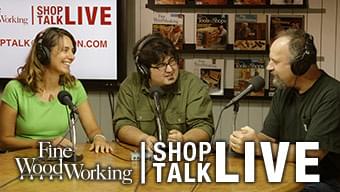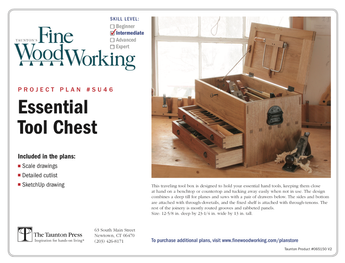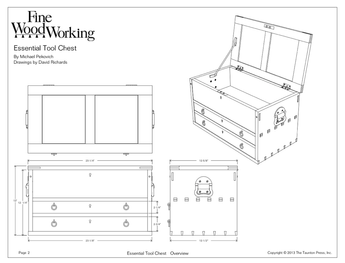As you can see in the attached photo, This guitar set has developed some cup. I’m interested to learn if it’s possible to remove some of the cup by moistening one side and clamping them, but I’m up for all ideas, especially ones that have worked. Any thoughts?
Discussion Forum
Get It All!
UNLIMITED Membership is like taking a master class in woodworking for less than $10 a month.
Start Your Free TrialCategories
Discussion Forum
Digital Plans Library
Member exclusive! – Plans for everyone – from beginners to experts – right at your fingertips.
Highlights
-
Shape Your Skills
when you sign up for our emails
This site is protected by reCAPTCHA and the Google Privacy Policy and Terms of Service apply. -
 Shop Talk Live Podcast
Shop Talk Live Podcast -
 Our favorite articles and videos
Our favorite articles and videos -
E-Learning Courses from Fine Woodworking
-
-













Replies
I have never tackled anything quite that thin, but with a few small table-tops I've had success. Given the thinness of your boards, if you try this technique, do so very carefully. You probably already know that the concave side has lost moisture to a greater extent than the convex side. What has worked for me is to moisten the concave side, and let the board dry with that side down and a heat source on the upper side.
The au naturale way to do this is to lay the board on the grass in gentle sunshine. A sheet of newspaper or tissue paper underneath isn't a bad idea. Living in the Great Northwet as I do, sunshine isn't an everyday commodity, so I've used a barely damp towel, and a chick-warming lamp placed judiciously (not too close).
When the board becomes flat, it's taken out of the sun and let dry with air circulating all around (stickered). If it cups again, the process is repeated, but the board is allowed to go just past being flat to being slightly cupped in the other direction. One table, I believe I did 3 times before it stayed flat when dried.
The important final step is to get some kind of finish on it quickly after it flattens. If it sits for too long it's likely to cup again.
Probably best to wait and see what other suggestions you get before trying this, but it might be worth a go.
Did you buy it at this thickness or did you re-saw it yourself? If you did it yourself, can you use the piece that's closer to being true quarter-sawn?
If not, forestgirl's method should work. If you wet the wood, add a few drops of glycerine to the water, to add flexibility. Once flat, smooth it and give it a couple of coats of shellac to keep it from cupping again but after it's dry, you'll want to either make the guitar or clamp it between a couple of very flat boards. If you'll be installing ribs and know where they'll be, tape those areas off or don't coat it, just clamp it flat. If the wood hasn't dried completely, you'll need to sticker it and let it finish that before making the guitar.
The top will need to be true quarter sawn, for stability.
Highfigh, thanks for the glycerin suggestion -- I didn't think of that, but it makes me feel less apprehensive, considering the thinness of the wood! I have a few thin instrument-type pieces of figured maple. Sounds like a good idea to try on them.forestgirl -- you can take the girl out of the forest, but you can't take the forest out of the girl ;-)
I bought it the way it is. FWIW, it's about 1/4" now and will be thinned to around 1/8". It's relatively old and feels quite brittle.
If yo are building a guitar then you should ask on a luthieres site. Once the back is thinned out the bracing and construction of the box work to flatten it.Pardon my spelling,
Mike
Make sure that your next project is beyond your skill and requires tools you don't have. You won't regret it.
This site is an example of what I found when I googled 'Lutherie forum':http://www.stringsmagazine.com/ubbcgi/ultimatebb.cgi and there are quite a few others. No doubt, they have experience with thin stock that may be fairly old and the wood in your photos looks like Brazilian rosewood, which has been on the 'Do Not Import' list in the US since the 1970s. Brazilian rosewood has been used extensively for guitars but less since it was put on the list. Please post photos when you're done.
"I cut this piece four times and it's still too short."
musical instrument makers forum http://www.mimf.com
Hi Quickstep: If your intention for the wood is to build a guitar with it you are not getting good advice here except to look on a luthiers site for help. You should NOT introduce any water to the wood. Proper thinning and building method will deal with the cup just fine. In other words, don't start with the idea that you have to remove the cup! If it is old brazilian and you also have same wood for sides, then you owe it to yourself to learn how to use it without abusing it.
"If it is old brazilian and you also have same wood for sides, then you owe it to yourself to learn how to use it without abusing it."
IMHO, if it is braz, old or new, you owe it to the wood NOT to attempt to learn how to build a guitar with it. I'm no luthier, but I know enough to know that much of the advice posted here was pretty much wrong. (E.g, and with all due respect, you don't finish the inside of a guitar. You rely on bracing to keep the instrument's shape.) Building a guitar is an involved process with potential pitfalls every step of the way. If you want to learn how to do it, my advice is to start with some maple or mahogany and leave the braz for your 10th attempt.
If the RW is not braz, and is not top grade, you need input from the musical instrument maker's forum -- luthiery is definately not ordinary fine woodworking, but is a beast unto itself where the rules are very different.
Mike HennessyPittsburgh, PA
Just for the record and for clarification.... I would like to think I'm a reasonably accomplished woodworker, but making a guitar is beyond my capability. One day I may give it a try and I will not make my first try with Brazilian Rosewood. I am passing this wood on to a luthier and I'm just trying to make his life a little easier. Sounds like the best way to do that is to leave it alone......
This forum post is now archived. Commenting has been disabled